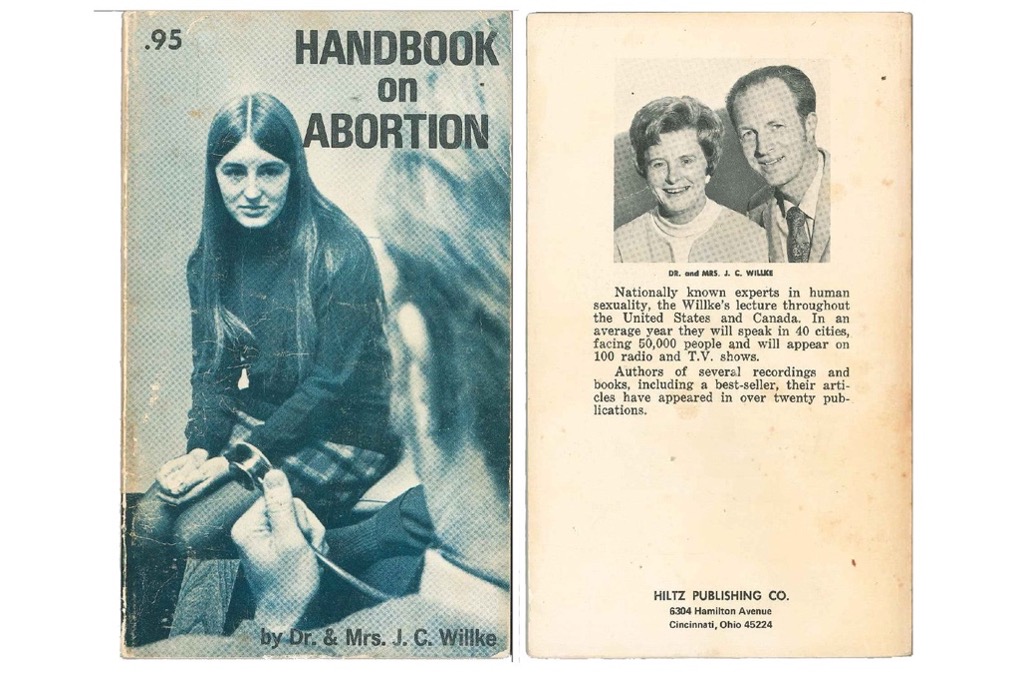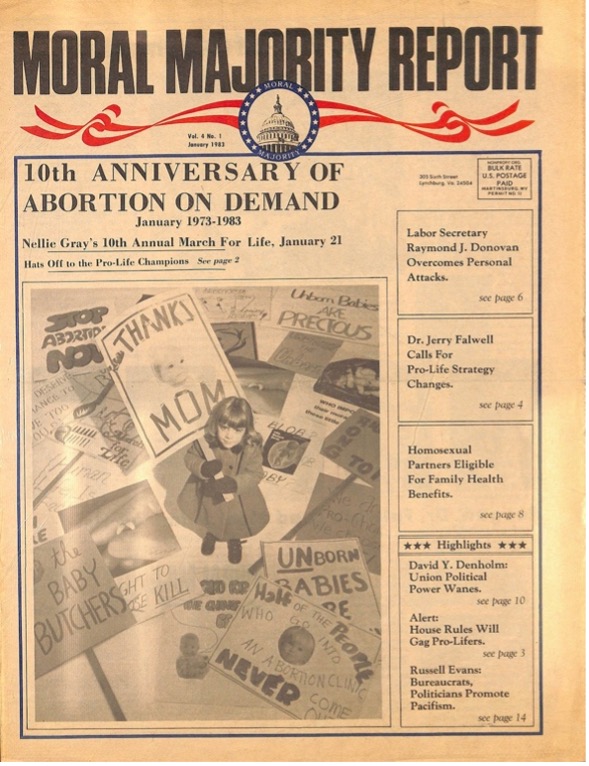The memory of Roe v. Wade can be explored through its relation to anti-abortion and pro-life movements and organizations both before and in the wake of the Supreme Court’s 1973 decision to legalize abortion. The tactics and methods used by those opposed to abortion in the US, leading up to and after Roe v. Wade, can be understood largely as the connection of other sites of memory, often associated with cruelty and the violation of the sacrosanct, to the practice of abortion. In this manner, the use of other memories as vehicles of emotion, understanding, and ideas can be viewed as a means through which the religious right and anti-abortion activists constructed abortion as a moral wrong and contributed to how Roe v. Wade is widely imagined and remembered.
Before the Roe v. Wade decision was rendered by the Supreme Court in 1973, anti-abortion activists used the partial nature of collective memory to construct and emphasize abortion as infanticide to promote their cause. Jennifer Holland argues that before the Roe v. Wade decision was rendered, the anti-abortion movement did not have much of an explicit religious tone, as evidenced by the extreme popularity of the Handbook on Abortion, written by Catholic husband and wife John and Barbara Willke, in the pro-life movement at the time [1]. The Handbook contained graphic pictures of abortions and fetuses [1]. These depictions helped form the understanding of the “fetus, legally and culturally, as a baby” among many Americans [1]. In this manner, the partial nature of the collective memory of abortion, as communicated by these fetal representations, can be seen in the inclusion of images only amplifying the narrative of the “baby” at risk of being “murdered” rather than promoting discussions concerning the viability of the fetus. The idea of the not-yet-born baby as a victim of murder as well as representations of developing fetuses as babies, then, were likely employed by pro-life activists and groups in an attempt to craft the official hegemonic memory of abortion as an act of violence against the innocent.

More Images of Inside the Handbook (Graphic): https://slate.com/news-and-politics/2022/06/fetal-photos-jack-barbara-willke-handbook-on-abortion.html
Moreover, after the Roe v. Wade decision was handed down by the Supreme Court, Roe and abortion itself in the US became a site of memory based on past memories of atrocities and suffering intertwined with ideas of family informed by conservative Christian ideology. Seth Dowland describes that Jerry Falwell, a Baptist preacher and the creator of the Moral Majority, a Christian activist group, declared the elimination of access to abortion as key in protecting and maintaining the American family [2]. The religious right also saw the family organization and gender roles they valued, informed by the Bible, as possible casualties of continued access to abortion [2]. This rhetoric likely reflects the mobilization of the particular and universal nature of collective memory to advance religiously motivated anti-abortion sentiment. Specifically, the idea of the family invoked by Falwell and the Christian right likely stirred up fear and anger among those concerned about the decay of the American family and, by extension, their own family through legal access to abortion. This may have helped create personal sites of abortion memory in families, furthering the anti-abortion cause. In addition, flyers printed and distributed by the Moral Majority described abortion as a “holocaust” and claimed similarities between Roe and the Dred Scott v. Sandford decision that reinforced the legality of slavery [2]. The use of the memory of the WWII Holocaust and American slavery by pro-life organizations illuminates the unpredictable nature of collective memory. Specifically, it shows how disparate historical events can be linked through their strong emotional power to contemporary issues like abortion in order to produce certain opinions and responses. The memories of human-caused tragedies and personal family decay, then, likely served as the frameworks through which the religious right sought Roe and abortion to be perceived in order to achieve the outlaw of abortion.

More Moral Majority Reports: https://daily.jstor.org/the-moral-majority-collection/
Furthermore, the religious right also manipulated the memory of contemporary and historical moments to shape how abortion and Roe v. Wade was understood and constructed in the American imagination. For example, Jerry Falwell specifically blamed the Roe decision handed down by the Supreme Court as the reason why abortion was taking place in the United States in the first place because he viewed the Supreme Court as a negative agent of liberal change [3]. This attribution by Falwell highlights the usable nature of collective memory. Particularly, since the practice of abortion was blamed on the Supreme Court’s Roe decision, the conservative right may have strategically used the collective memory of the decision to create a clear target for their political action and religious anxieties. Additionally, in 1980, a Christian rally called Washington For Jesus (WFJ), which promoted anti-abortion sentiment among other conservative ideas, was planned to be held on the date of the anniversary of the landing of English colonists at Jamestown [4]. This, again, illuminates the usable nature of collective memory. The conflation of anti-abortion sentiment with what many may consider the “birth” of the US fictitiously roots anti-abortion activism and ideas in the foundation of the US, giving pro-life and anti-abortion movements the perception of being legitimate and traditional. Therefore, the usable nature of collective memories, like the memory of the impacts of Roe, real or not, and the “birth” of the US, was likely key in forming the US perception of Roe v. Wade and abortion.
Anti-abortion activists and the religious right emphasized specific aspects of the collective memory of abortion to craft desired understandings and perceptions of Roe v. Wade and abortion itself. This practice highlights the significant influential power of connecting past and contemporary memories to issues like access to reproductive care in order to promote particular narratives and histories. Additionally, an examination of the ideas and memories evoked by anti-abortion activists both before and after Roe v. Wade was rendered in 1973 provides insight into the continuity that existed and the changes that took place in the promotion of the pro-life cause.
Emma Powell
Sources for Post
[1] Holland, Jennifer. “Abolishing Abortion: The History of the pro-Life Movement in America.” The American Historian. Organization of American Historians. Accessed April 20, 2023. https://www.oah.org/tah/issues/2016/november/abolishing-abortion-the-history-of-the-pro-life-movement-in-america/#fn8.
[2] Dowland, Seth. “‘Family Values’ and the Formation of a Christian Right Agenda.” Church History 78, no. 3 (2009): 606–31. https://doi.org/10.1017/s0009640709990448.
[3] Williams, Daniel K. “Jerry Falwell’s Sunbelt Politics: The Regional Origins of the Moral Majority.” Journal of Policy History 22, no. 2 (2010): 125–47. https://doi.org/10.1017/s0898030610000011.
[4] Williams, Daniel K. God’s Own Party: The Making of the Christian Right. Oxford: Oxford University Press, 2012. https://books.google.je/books?id=lqf3KBaqgI8C&printsec=copyright#v=onepage&q&f=false.
Sources for Photos
[5] Wallenbrock, Emma. “The Photos That Jump-Started the pro-Life Movement.” Slate Magazine. Slate, June 8, 2022. https://slate.com/news-and-politics/2022/06/fetal-photos-jack-barbara-willke-handbook-on-abortion.html.
[6] “The Moral Majority: Collection of Primary Sources .” Open Community Collections. JSTOR, July 1, 2022. https://daily.jstor.org/the-moral-majority-collection/.
It’s very interesting how activists have used american cultural memory to inform and influence their rhetorical and organizational anti-abortion strategies. I never would have imagined some of the connections that were made such as the connection to Jamestown. However, similar tactics can be seen on both sides of the debate. Pro-choice advocates frequently point to the history of abortion in the American colonies as evidence that the practice is fundamentally “American” or at least holds historical precedent. For an issue that so quickly became THE hot button issue debated in the United States, it’s not surprising that activists sought to utilize american cultural memory as justifications for their beliefs. What is important is studying how they did this to better understand the usability and manipulability of memory.
I remember reading that prior to Roe v Wade, abortion as an issue was not that bipartisan. Interestingly, the religious right has capitalized on this issue and brought it to the forefront of the agenda. Since abortion is so highly controversial nowadays from both sides, our collective memory of a time before this polarization is dwindling. It is important to look back at history to realize the different ways abortion has been viewed.
i think the connecting of abortion to events in history that caused mass destruction and murder is very interesting and shows the true nature of anti-abortion activists and their true understanding of abortion itself. Them connecting abortion to events like the holocaust is inhumane and shows that they truly dont understand the reasons behind why a person would get an abortion or anything that really goes into play in getting one.
I have heard ways that people connect abortion to genocide and it always makes me think. Comparing anything to genocide creates this understanding that a violent act is occurring on a massive scale. I do see how people could make the connection, however it only works in this black-and-white way of thinking in that the fetus is the victim and the mother is the aggressor. It strips humanity away from the mother, and makes it almost impossible to even begin to understand her point of view or her decision because she is made to be a criminal committing a violent act.
A point of view that I think holds slightly more merit is the threat that abortion may have on the family unit. There is an obvious correlation between countries that have strong family units and the rates of violent crime. America itself already has a dysfunctional idea of the family unit as a whole, and it is apparent that family itself is not among the highest of values to many Americans. Because of the correlation I can understand the want to preserve the family unit, but to be frank I don’t think that it is salvageable at our state as a nation regardless of the abortion legislation. Abortion is not the biggest threat to the safety of families currently.
This is a great analysis article. Your ties to significant historical events paired with your connection to timeless concepts such as emotion really provides a unique perspective. I especially noted the part where you talked about the link between emotions and law. It seems so counterintuitive that something so concrete like laws and the justice system would be determined and motivated by something so biased like emotions. Do you think that it is fair that our laws are motivated by subjectivity of human emotion?
I really enjoyed reading your post, it had a lot of history dealing with Roe v Wade. something that stood out to me was learning about the Handbook on Abortion. This first made me think that it was something that helped people get abortion however what I learned was that this was actually used by people who are prolife and antiabortion. It was interesting to see the images of the cover of the book. Also, I noticed that the morality report came out ten years after the Roe v Wade case. This reminds people and continues to put abortion issue in there memory, keeping Roe in the collective memory.